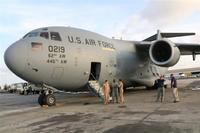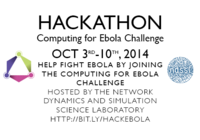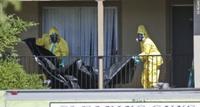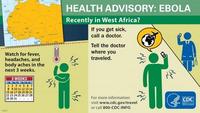-
U.S. to commit 4,000 soldiers, $750 million in the next six months to fight Ebola in Africa

The Pentagon’s effort to help eradicate Ebola in West Africa will require roughly 4,000 American soldiers, cost $750 million for the next six months, and may last longer than a year.American troops will help build seven testing labs and seventeen treatment facilities by mid-November, but troops will be on the ground in Liberia for at least a year.A majority of U.S. soldiers will not come in direct contact with Ebola patients, but a few dozen troops trained to operate in nuclear, biological, and chemical environments will be assigned to testing labs.
-
-
Texas officials question state preparedness for an outbreak
Following the death of Texas Ebola patient Thomas Duncan, many leaders in Texas are considering whether the state is prepared to handle a more wide scale public health emergency. The problem, analysts say, is that many local health departments in the state are run autonomously, and have split funding between local, state, and federal sources. As a result, they are not often all held to the same standard, and these disparities could be what would ultimately lead to disjointedness and failure to respond properly to an outbreak.
-
-
The U.S. is not at risk of an Ebola epidemic: Experts
The United States is highly unlikely to suffer an Ebola outbreak, according to the Centers for Disease Control and Prevention(CDC). Although U.S. hospitals have not had to deal with Ebola in the past, Western health institutions have studiedthe disease since it was first discovered in 1976 in Zaire, now the Democratic Republic of the Congo, positioning the CDC better to inform the public about Ebola, its symptoms, and how it spreads.
-
-
Computing for Ebola Challenge

Researchers at the Network Dynamics and Simulation Science Laboratory (NDSSL) have been using a combination of modeling techniques to predict the spread of the Ebola outbreak. As part of those efforts, the team created an adaptable set of global synthetic populations, allowing for rapid response as the situation continues to unfold. The synthetic populations and other informatics resources are now openly available to aid other researchers and citizen scientists. The NDSSL is hosting a Computing for Ebola Challenge from 3 October to 10 October 2014. The goal of the hackathon is to develop an application to combat the Ebola epidemic. All are welcome to join.
-
-
Candidates of both parties use Ebola crisis to attack opponents
Democratic and Republican campaign officials are uncertain about the political ramifications of Ebola’s arrival in the United States, but some congressional candidates have already used the topic to connect with voters. A poll by the National Republican Senatorial Committee(NRSC), the campaign group for Senate Republicans, found that 60 percent of voters believe Ebola should be treated as a major crisis by the White House if a single case of Ebola is found in the United States. Even congressional Democrats who have been supportive of Obama’s position toward the Ebola crises have used the Ebola epidemic against opponents.
-
-
CDC urges hospitals to follow Ebola-related protocols

The CDC had called for medical facilities to be on high-alert for Ebola-like symptoms, but these plans are only as effective as the practices of each hospital, and the recent Dallas case was marked by a mix-up at Texas Health Presbyterian Hospital. “We’re reiterating the message for every health worker in this country — think about travel history. If someone’s been in West Africa within twenty-one days and they’ve got a fever, immediately isolate them and get them tested for Ebola,” CDC director Thomas Frieden said.
-
-
Securiport’s advanced biometric immigration control systems help in fight against Ebola
Securiport says it is supporting the fight against the Ebola virus in West Africa by providing advanced biometric screening technologies and comprehensive contact tracing data analytics to help governments and health organizations monitor and control the spread of the virus. The company’s immigration control systems are now in place across a total of seven West African nations, including Sierra Leone, Senegal, and Ivory Coast.
-
-
Dallas Ebola patient was sent home as a result of a flaw in software used by many hospitals

Before Thomas Eric Duncan was placed in isolation for Ebola at Dallas’ Texas Health Presbyterian Hospitalon 28 September, he sought care for fever and abdominal pain three days earlier, but was sent home. During his initial visit to the hospital, Duncan told a nurse that he had recently traveled to West Africa — a sign that should have led hospital staff to test Duncan for Ebola. Instead, Duncan’s travel record was not shared with doctors who examined him later that day. This was the result of a flaw in the way the physician and nursing portions of our electronic health records (EHR).EHR software, used by many hospitals, contains separate workflows for doctors and nurses.
-
-
Number of Ebola cases in Liberia, Sierra Leone to reach 1.4 million by mid-January 2015: CDC
A new study by the Center for Disease Control and Prevention (CDC) says that a model developed by CDC to estimate the spread of the Ebola virus shows that if current virus proliferation trends continue without additional interventions, the number of Ebola cases in Liberia and Sierra Leone will reach 1.4 million by mid-January 2015.
-
-
Research predicts possible 6,800 new Ebola cases this month
New research predicts new Ebola cases could reach 6,800 in West Africa by the end of the month if new control measures are not enacted. The researchers also discovered through modeling analysis that the rate of rise in cases significantly increased in August in Liberia and Guinea, around the time that a mass quarantine was put in place, indicating that the mass quarantine efforts may have made the outbreak worse than it would have been otherwise.
-
-
Climate change makes Europe hospitable to Dengue fever
Dengue fever is a tropical disease caused by a virus that is spread by mosquitoes, with symptoms including fever, headache, muscle and joint pain. Each year, dengue infects fifty million people worldwide and causes approximately 12,000 deaths — mostly in South-east Asia, and the Western Pacific. Scientists say that Dengue fever could make headway in popular European holiday destinations if climate change continues on its predicted trajectory.
-
-
Liberia quarantines area the size of Wales in an effort to contain Ebola spread
In an effort to control the spread of Ebola throughout West Africa, Liberia has quarantined areas at the epicenter of the epidemic. Experts say the quarantine is not likely to be effective because of two reasons: people inside and outside the quarantined areas – called “Unified Sectors” – still lack effective medical services, and the growing shortages of food and clean water inside the Unified Sectors will force people from inside those areas to go outside in search of food. The areas – which, combined, are the size of Wales — are too large to be effectively monitored.
-
-
Ebola poses no risk in U.S.: Experts
Ebola has infected nearly 2,000 people in West Africa because the disease is spreading in populated areas with poor public health infrastructure, and where health workers might not be taking proper infection control procedures, such as wearing gloves, experts say. These experts note that Ebola can be contracted only from patients who have the symptoms, not those who are infected, and even then infection occurs only when coming into contact with bodily fluids. They say that SARS and the flu are more contagious than Ebola.
-
-
CHIKV Challenge: Forecasting the spread of infectious disease
Modeling the future spread of infectious diseases is extremely challenging. Many current infectious diseases models tend to be based on historic data. There are numerous sources of potentially useful data that could be incorporated into a forecast, but it is difficult to predict which will be most informative. One goal of DARPA’s Chikungunya virus (CHIKV) challenge is to inspire the creation of teams drawn from multiple disciplines, including not only specialists in public health and infectious disease, but also experts in mathematics, meteorology, entomology, computer science, and bioinformatics, among other fields. The teams will build models that predict the spread of the Chikungunya virus in the Americas. the products could be applied to other diseases and inform responses to emergencies.
-
-
Ebola vaccine to be tested on humans
Efforts to test an Ebola vaccine on humans have reached a milestone when BioProtection Systems, through its parent company, NewLink Genetics Corporation, confirmed that it is prepared to launch the first human safety trial of a vaccine, which the company licensed after it was developed by scientists at the Public Health Agency of Canada. Thevaccine replaces the genes from vesicular stomatitis virus (VSV), a pathogen found in livestock, with a gene from the Ebola virus. The Ebola gene then develops a harmless protein that sits on the virus’s outer coat.
-
- All
- Regional
- Water
- Biometrics
- Borders/Immig
- Business
- Cybersecurity
- Detection
- Disasters
- Government
- Infrastructure
- International
- Public health
- Public Safety
- Communication interoperabillity
- Emergency services
- Emergency medical services
- Fire
- First response
- IEDs
- Law Enforcement
- Law Enforcement Technology
- Military technology
- Nonlethal weapons
- Nuclear weapons
- Personal protection equipment
- Police
- Notification /alert systems
- Situational awareness
- Weapons systems
- Sci-Tech
- Sector Reports
- Surveillance
- Transportation
Advertising & Marketing: advertise@newswirepubs.com
Editorial: editor@newswirepubs.com
General: info@newswirepubs.com
2010-2011 © News Wire Publications, LLC News Wire Publications, LLC
220 Old Country Road | Suite 200 | Mineola | New York | 11501
Permissions and Policies
Editorial: editor@newswirepubs.com
General: info@newswirepubs.com
2010-2011 © News Wire Publications, LLC News Wire Publications, LLC
220 Old Country Road | Suite 200 | Mineola | New York | 11501
Permissions and Policies
